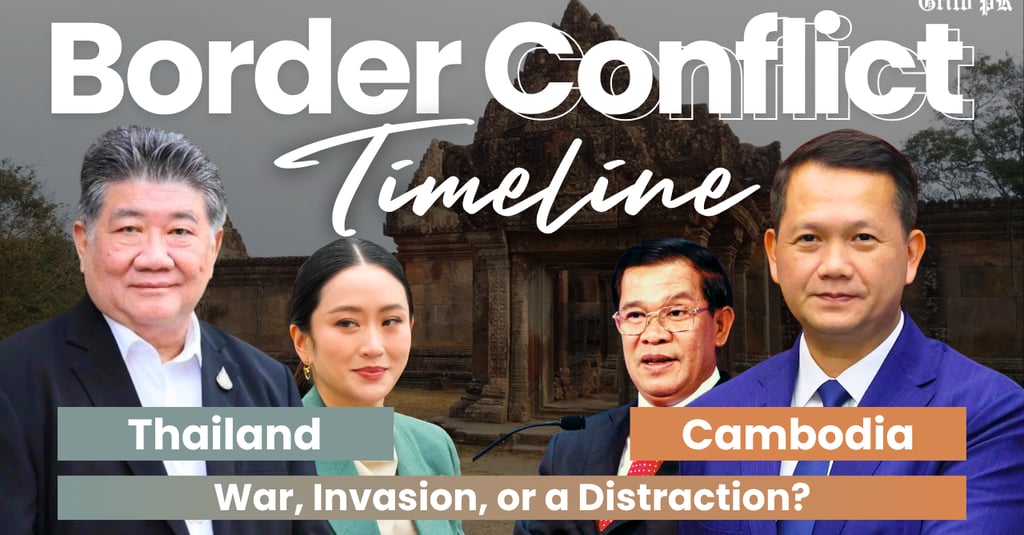Thailand v. Cambodia Border Conflict: Is it War, an Invasion, or a Distraction?
Since the International Court of Justice (ICJ) ruling in 2013, which granted Cambodia sovereignty over the Preah Vihear temple and its surrounding areas, Thailand has disputed the border limits and tensions have never ceased. In recent months, both countries have exchanged accusations, and this week, armed clashes escalated to levels not seen in over a decade. Here are the key facts, the latest fighting, and how the international community is trying to stop the conflict.
TODAYS NEWSINTERNATIONAL
Isabella Perez • Investigative & Political Journalist
7/27/20254 min read


Background Info
Thailand and Cambodia have had tension about ill-defined borders since the end of the 1950s French-colonial era. Border dispute locations usually fall upon ancient and sacred temples that both nations claim to culturally identify with. Both countries have recently accused each other of escalating violence. The last time there was violence at the Thai-Cambodian border was from 2008 to 2011.
Recent Escalation Timeline
May 28th, 2025: Thai and Cambodian soldiers exchanged shots at the Emerald Triangle, and while most first-hand reports say that Thailand's soldiers shot first, Thailand disputes the claim. There was one reported casualty, a Cambodian soldier.
June 12th, 2025: Cambodia bans Thai imports, pauses all Thai broadcasts, and threatens to stop buying electricity or internet bandwidth from Thailand.
June 14th, 2025: Cambodia and Thailand's Boundary Commission meets in Phnom Penh to talk about a resolution. They reach no agreements. Cambodia restates the International Court of Justice's (ICJ) ruling from 2013 that they legally own the temple and surrounding areas. Thailand threatens to close border crossings to Cambodia.
June 24th, 2025: Thailand officially closes border crossings to Cambodia and threatens to stop supplying them with electric power and internet. Cambodia responded by banning Thai fuel imports.
July 1st, 2025: Thailand’s Constitutional Court suspends Prime Minister Paetongtarn Shinawatra because of a leaked phone call she had with former Cambodian leader Hun Sen, where she attempted to negotiate peace. Opposing political forces were furious as she criticized a Thai army commander in the leaked call and saw this as Paetongtarn compromising Thai sovereignty, while she stated that she was only trying to protect Thai soldiers. Deputy PM Phumtham Wechayachai has been acting as Thailand’s leader since Paetongtarn's suspension. (For more details on the political power structure of Thailand: Read Here.)
July 16th, 2025: One of Thailand's soldiers had their leg blown off and two others were injured by a landmine in Ubon Ratchathani. Thailand accuses Cambodia of having planted the mines, and Cambodia says the mines have been scattered along the border since World War II. Cambodia also states that the Thai soldiers wandered away from agreed patrol routes into dangerous areas.
July 21st, 2025: Thailand claims to have found 10 Russian-made PMN-2 mines between July 18th and July 20th, claiming that Cambodia has violated the Ottawa Treaty and is inciting violence. Thai authorities began issuing border closings after the supposed discoveries and recalled their ambassador.
July 24th, 2025 (1st Day of Violent Conflict): At the Ta Moan Thom temple, Thailand claims Cambodia fired the first rockets and artillery to invoke violence. Cambodia denies this claim, calling it 'baseless,' and says Thailand started attacking unprovoked. The Thai military reported retaliating with six F-16 fighter jets that bombed Cambodia's military positions, and Cambodia responded with BM-21 rocket systems fired into Thai civilian areas.
Cambodia's retaliation ended in 11 civilians and 1 soldier dying in the Sisaket and Surin provinces. Cambodia alleges that Thailand engaged in “reckless and brutal military aggression." Thailand also alleges that Cambodia initiated the violence.
July 25th, 2025 (2nd Day of Violent Conflict): Heavy artillery and rockets continued to be used while ASEAN and the UN called for immediate ceasefire. Cambodia officially requested UN intervention. Both countries continued the narrative that they were acting in self-defense and that the opposing country initiated violence.
July 26th, 2025 (3rd Day of Violent Conflict): Conflict continued by the Trat province in Thailand and the Pursat province in Cambodia. Thailand's defense forces say they lost 13 civilian lives and 7 soldiers, while Cambodia reports losing the lives of 5 soldiers and 8 civilians. From July 24th to July 26th, 30+ people have died on both sides, and 130,000 have been evacuated from locations along the border.
Which culture is more closely tied to the temples?
Preah Vihear is an 11th-century Khmer Hindu temple built during the Khmer Empire, in what is now Cambodia and parts of Thailand. Khmer culture is more central and relevant to Cambodia, since most Cambodians are ethnically Khmer and Khmer is the official language.
In Thailand, Khmer culture has mostly been shared and incorporated into aspects of Thai culture, especially in the Northeast. Most people in Thailand are part of the Central Thai ethnic group, which migrated from Southern China into Southeast Asia around a thousand years ago.
Overall, the Temple of Preah Vihear expresses more cultural relevance and significance to the ethnically Khmer majority of Cambodia, although Khmer culture is shared along both sides of the border. While the temples are significantly iconic in Thailand, they mostly dispute the surrounding areas.
War or Distraction?
Neither country has officially declared war, and both claim to be acting in self-defense, yet surrounding nations and international media reference the conflict as “the worst undeclared border conflict in decades.” Conflict experts mention the serious driving forces are coming from Thai military pressure and Cambodian nationalism. Thailand seems to blatantly ignore the International Court of Justice's ruling that Cambodia has sovereignty over the temples and surrounding areas.
Citizens of both countries are skeptical of how their governments are leveraging the conflict to push ideas of nationalism and authoritarianism. Many say that the conflict is being used to distract from the economic instability being created by the newly implemented US tariffs on both countries.
Mediation: China? United Nations? Donald Trump?
ASEAN (led by Malaysia’s Prime Minister, Anwar Ibrahim) and the United Nations have offered mediation. The UN Security Council met July 25th to discuss a ceasefire. China also offered mediation in hopes of supporting stability in the region.
While on a trip to Scotland, United States President Donald Trump announced he spoke to both countries and they agreed to meet for a ceasefire immediately. He also mentioned that he threatened to withhold future trade deals with Thailand and Cambodia if the conflict continued. He did not address any tariff-related discourse, despite economic uncertainty potentially being a driving factor of tensions, a common reason that nationalist rhetoric spreads in nations.
A ceasefire has been under negotiation as of July 26th due to international pressure for regional stability and the USA's threats of further economic instability.
